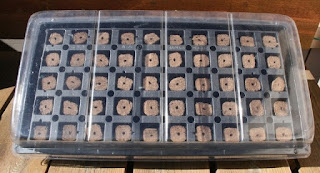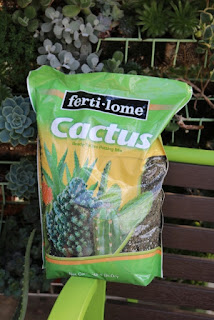It’s
just about time to sow seeds indoors and here are some ideas to get you started.
First, starting plants from seed is a great way to get exactly the variety of
peppers and tomatoes you want. In addition, tomatoes, peppers, eggplant require
long growing seasons and do best by starting them early indoors. Beans, peas,
radishes, lettuce and many other vegetables do best when sown directly into the
garden. You can start these vegetables indoors, but they typically don't transplant
well. You're better off to seed them directly.
In fact, many of these vegetable seeds can be planted in the ground in
early March.
Begin by selecting the
variety of tomato or pepper you want to grow. For best results, select a
quality seed from a local supplier.
Next, you'll need seed starting trays and
inserts. There are a number of inserts you can use to start your seeds,
including different sized trays as well as plugs such as Rapid Rooters.
You can
also choose peat pots in a variety of sizes to start your seeds in. Peat pots
can be planted directly, which reduces transplant shock.
Add a 2" or
7" dome to help keep in the moisture, while your seeds sprout. This setup
features a tray, Rapid Rooter insert and 2" dome.
Once you have your
starter containers, pick up some seed starting mix. Use seed starter, not
potting soil. You'll have much better results. It's a good idea to moisten the
seed starting medium before you sow your seed.
Check the back of the seed packet for sowing
instructions. The seed package will tell you how deep and how far apart to
plant the seeds. Heat mats help seeds germinate faster and root deeper, by
keeping the soil temperature constant. Even if the room cools off at night, the
soil stays warm and seeds will sprout faster.
Once your seeds are up and have
grown two or more sets of leaves, it may be time to add some supplemental
lighting. An easy way to do this is to purchase a grow system like Jump Start.
This system comes complete with a stand and T5 grow light. You can also buy T5
grow bulbs individually, as well as T12 grow bulbs that will fit your shop
light fixtures. Providing adequate lighting is one of the most aspects of
growing strong, healthy seeds indoors.
Feed your seedlings with a mild liquid fertilizer once they've developed
three or more sets of true leaves. As your plants grow, ruffle them once a day
with your hand. This helps them grow stocky and strong. As for timing, the
first or second week in March is just about right. Starting your own seeds is a
very rewarding way to extend your gardening season.
www.theflowerbin.net
www.theflowerbin.net
Thursday, February 23, 2017
Thursday, February 16, 2017
Spring Classes at the 'Bin
We
believe the more you know, the better your garden will grow and to help you
continue to develop your gardening skills, we’re offering six very special
classes this spring. All of our classes are free, but we do ask that you sign
up in advance for each class. Sign up is easy. Call 303-772-3454 and tell us
the classes you want to take and we'll sign you up. Or, sign up in person when
you're in the store. Sign up sheets are right by the coffee bar.
We start this
season's spring classes with Kirk Fieseler speaking about the wide variety of
native and alpine plants and how to bring the beauty of these plants into your
own backyard. Kirk has hands-on experience with designing and building many
rock gardens and his passion for alpine and native plants will inspire you.
Whether you've got a rock garden you want to improve or have always wanted to
build one, this is the class for you. This class is scheduled for Saturday,
February 25th at 11am.
Well-known local author and speaker Don
Eversoll loves his heirloom tomatoes and in this class, he will teach you how
to grow the best heirloom tomatoes ever. This class is scheduled for Saturday
February 25th at 2pm.
Edible
landscaping is a mixture of beauty and utility. There are tasty and ornamental
plants for almost any garden setting. The Flower Bin's Perennial Specialist
Kara Gonzalez's will teach you how to create a beautiful garden landscape that
is also edible! Kara’s class is Saturday March 4th at 11am.
As
gardeners, we're always looking to ways to do things better. Michael Morris
will lead a discussion on how to get the best out of your garden this year.
This class will be a great place to get answers to all your gardening
questions. Attend Michael’s gardening class Saturday March 4th at
2pm.
Love to garden but don't have a lot
of space? The Flower Bin's own Kim Jackson and Ramona Mooney have the solution.
Their class on gardening in small spaces will include container gardening,
straw bale gardening and square foot gardening. These techniques will help you
grow a lot of great food in a small space. Kim and Ramona’s class is scheduled for
Saturday March 11th at 11 am
For many gardeners, choosing the right plants for your landscape can be
confusing, especially if you want to grow more native varieties. Pat Hayward
has more than 35 years experience in Colorado's garden and nursery industry,
including 9 years as Executive Director of Plant Select®. In this class, Pat
will share some of the best native plant selections to grow in your garden. Pat’s
class is scheduled for Saturday March 11 at 2pm.
Thursday, February 9, 2017
Flowering Gifts for Valentine's Day
Valentine's
Day is the perfect opportunity to delight that special someone in your life. A live flowering plant
is a very personalized gift and will remind them of you long after
Valentine's Day is over. Some plants to consider for Valentine's Day include
African violets, azaleas, bromeliads, cyclamen, cineraria, kalanchoe, orchids and
African violets. Most of these plants will do well in bright, indirect light.
Orchids come in a variety of colors and are easy to care for, if you keep them in a bright spot and watch the watering.
Make a statement this Valentine’s Day with a beautiful
flowering Bougainvillea. This one features variegated foliage as well as
outstanding blooms.
African violet plants like a spot that has bright, indirect light. They prefer
to be water from the bottom.
Azalea plants do best in a slightly cooler spot,
so once Valentine's Day is over, place them in a cool (about 65) bright spot.
For a more tropical look, choose one of the bromeliads. Bromeliads are
low-maintenance plants related to pineapples. They don’t need much water and
are fairly easy to grow.
Cineraria plants are available in red and purple
colors.
Cyclamen will tolerate lower light and cooler temperatures and like to
be kept moist.
Kalanchoe will do well in the low humidity of most houses this
time of year. They like to dry out a little between watering. Place them in a
bright room, out of direct sunlight. With a little care these colorful plants will
bloom for many weeks after Valentine's Day.
Thursday, February 2, 2017
Indoor Succulent garden tips
Growing
succulents adds a whole new dimension to your indoor garden. There's such a
wide variety of colors and textures to choose from and getting started growing
succulents is easy.
Begin by selecting a container. Succulents have shallow
roots so a shallow pot, dish or bowl is an ideal choice. Just make sure the
container you select has good drainage. Once you've decided on a container,
it's time to go shopping for plants.
If
you leave your plants in their original small pots, it's easy to move them
around in the container until you get the arrangement you like best.
Next, choose a soil that is specific for
succulents. Add enough soil to your container so that your plants will sit just
below the rim of the pot. This will keep water and soil from overflowing the
sides of the pot when you water. Carefully remove your succulents from their
containers and place them in your new pot.
They should be planted at the same
level they were growing in their nursery pot. You can add more soil at this
time if you need to. Once planted, you need to water your new garden
thoroughly. Water enough so that water comes out the drain holes. Now you're
done watering your succulent garden until it dries out completely. The key to
keeping your succulents healthy is to water more, but water less frequently.
Succulents like to have their roots soaked and then they want to dry out before
the next watering. It's best to water
succulents when they need it, not on a schedule, such as every week.
Fertilize
your succulent garden every three to four weeks with a low Nitrogen fertilizer
such as Cactus Juice. Give these
extraordinary plants a chance. Succulent care is easy and succulent gardens and
terrariums will brighten any home and office space.
Subscribe to:
Comments (Atom)





























